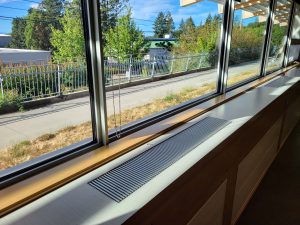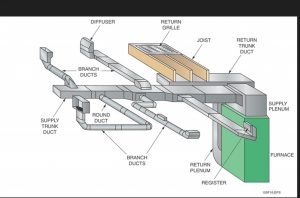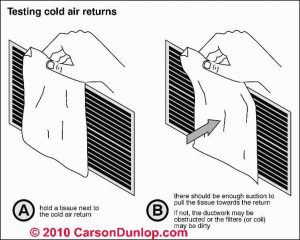7 Placing a Unit, Grills and Registers
Once we have thoroughly read and understand the manufacturer’s instructions, we start to design the system. We decide where to place the unit and the supply registers. The unit is placed centrally in the home and the supply registers are place according the heat loss requirements of each room.
Supply Registers Each room will have specific heating requirements based off the heat loss calculations; size, the number of exterior walls, floor and ceiling space and construction methods used, are all part of heat loss. The heat loss number obtained is converted to a CFM requirement for the space and the duct is sized accordingly. Some rooms may require 1 supply outlet and some rooms will need multiple. Supply outlet are placed at windows and other outside wall/floor locations. This is always along the outside perimeter of the building. The exterior walls, ceiling and floor will all lose heat energy through conduction. 
So when we locate the supply lines at these cold areas, we blanket that area with heat. This takes away the cool air circulating throughout the living space and keeps the interior of the rooms at a more balanced temperature.
Return Grills-Once the supply runs are established, we decide on the return lines. A return duct in most residential systems is unlike the supply. It is not individual lines to every room, but more centrally located to serve multiple rooms and placed on an interior wall or floor area. 
We look for large, open spaces, like living rooms and hallways. We decide on 2 or 3 (or more depending on system requirements) central return inlets in these spaces. This is to promote mixed air to be drawn back into the system for reconditioning. The more balanced the system, the better it operates. A building or room with temperature fluctuation does not make for a comfortable living space. We want the living space at an even temperature throughout and the placement of supply and return dust will accomplish this. Also, keep in mind that the return system is under a negative pressure and is drawing air back to the unit.  This is why we will find lint and debris around return lines and not at supply. Debris around supply outlets is an indication something is not operating correctly, as the supply air should push the debris away.
This is why we will find lint and debris around return lines and not at supply. Debris around supply outlets is an indication something is not operating correctly, as the supply air should push the debris away.
